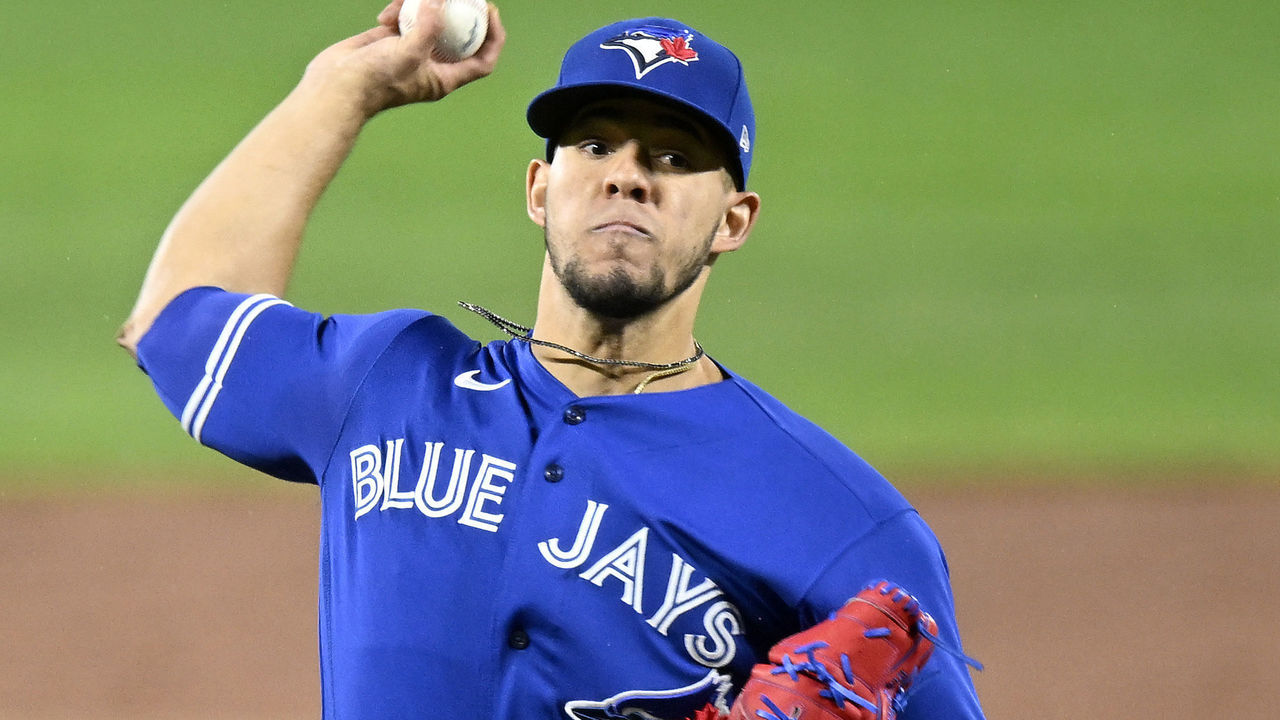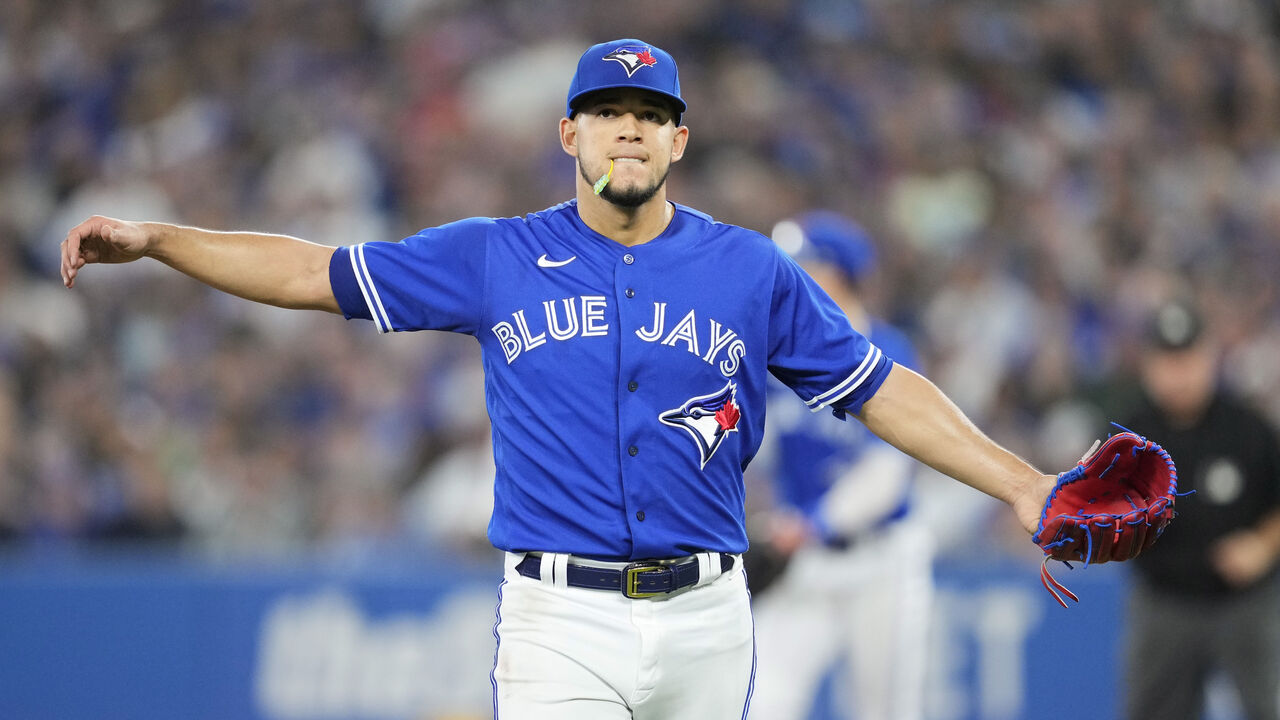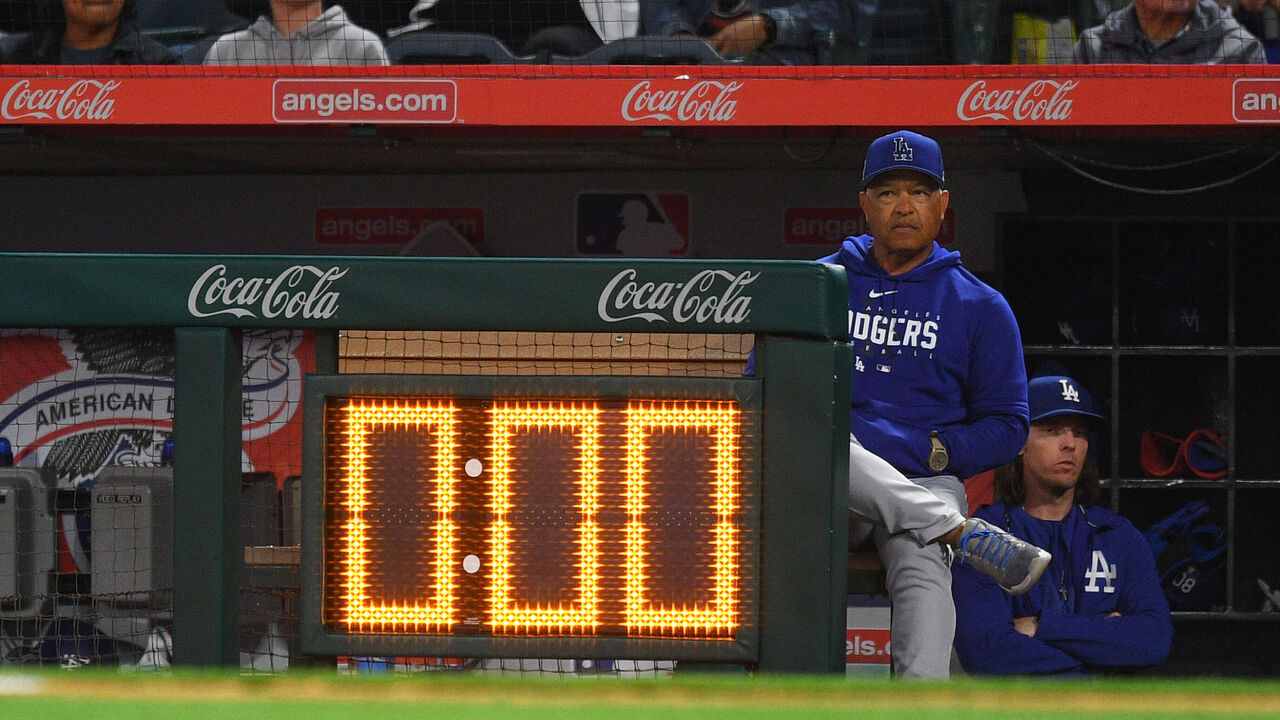Berrios is walking a tightrope, and the new rules have made a new game
Leading off …
Late this spring, there was optimism for Jose Berrios.
Berrios explained in late March in Dunedin, Florida, that his focus this offseason was trying to develop more consistent balance over his right leg, his drive leg, while keeping his front side closed. He hoped this focus would create more consistent fastball command.
"Trying to get on line to the plate with every pitch," he told me about his more direct path.

Coming off the worst full season of his career, and entering the second year of a seven-year, $131-million deal with the Toronto Blue Jays, the Blue Jays and Berrios were focused on improving his fastball command - particularly glove side, or inside, against left-handed batters.
"With a track record like his, his first six or seven years in the league, I think it is mostly pitch selection and staying out of damage areas," Blue Jays manager John Schneider said near the close of camp. "That's where I think fastball command is going to be key for him. We've broken it down pretty in-depth in the offseason and he's on board with it."
He threw a career-low number of fastballs on the edges of the plate (7.1% of all offerings) against lefties last year. Too many fastballs drifted to the heart of the strike zone, and when they did, they were crushed.
Berrios allowed a career-worst batting average of .447 to lefties on fastballs in the "heart" of the strike zone, according to MLB's Statcast data - which was more than .100 worse than his next worst season.
He allowed 29 home runs last year, sixth most in the majors, and left-handed hitters crushed 20 of them; 12 came via Berrios' fastball. Only Josiah Gray of the Nationals allowed more home runs to lefties.
There were signs of improvement this spring. For instance, in his final tuneup on March 28, Berrios locked up Phillies left-handed batter Brandon Marsh with a well-located, 95-mph two-seam fastball away.
But the first regular season test resulted in a failing grade Monday against a Royals lineup that had struggled in its first series against the Twins. Berrios allowed eight runs and 11 baserunners in 5 2/3 innings. Too many fastballs again caught too much of the plate.

After a three-run first inning, fastball command became an issue again in the fourth.
Berrios left a fastball over the plate to Hunter Dozier who ripped the ball to right. The left-handed hitting Jackie Bradley Jr. followed by slashing another fastball that caught too much plate for a single. And Nicky Lopez, batting left-handed, was able to get his hands in and drive a better-located fastball - but one that still caught a bit too much plate - to split the gap for a two-run triple.
The problem for Berrios is that he doesn't have much margin for error. The 29-year-old is going to have to have impeccable command because his arsenal is trending down in relative terms.
While his fastball velocity has remained steady, the rest of the league's velocity keeps improving. His four-seam fastball has ranked below the league average in FanGraphs' run values for three straight years. It's in the middle of the pack in terms of spin, speed, and release extension. Deception is hard to evaluate, but he seems to lack that quality.
And at a time when many pitchers are adding or refining their arsenals, Berrios' pitch mix remains largely unchanged. While it worked well from 2016-21 when he ranked 25th in pitching WAR, Berrios might be in need of a new shape to throw off batters.

The Blue Jays' rotation doesn't need more question marks.
Chris Bassitt's velocity was down in his first start Sunday, as it was throughout the spring, raising some alarm. He allowed three home runs in the first inning as he was roughed up by an excellent St. Louis Cardinals lineup. Opening Day starter Alek Manoah was shaky, though his average fastball velocity was 94.2 mph, slightly up from last year.
The Blue Jays have an excellent lineup and much-improved outfield defense. But to advance deep into October, elite performance from their top-of-the-rotation arms is a must. Perhaps Kevin Gausman and Manoah can be those arms, but it's increasingly looking like Berrios will not be the candidate to fill such a role without a more extreme makeover.
No. 2: The most dramatic change related to the new rules? The pace of play.
Nine-inning games averaged 2 hours and 39 minutes through Monday.
If that holds, it'll mark the lowest average time since 1984 (also 2:39).
Major-league games averaged 3:10 in 2021, the slowest on record, and improved by seven minutes last season thanks to PitchCom.
This appears to be the new pace of the game. Spring contests were 26 minutes faster, and minor-league matchups were 25 minutes speedier last campaign with the clock. While the total time of a game matters for widening the base of fans, what's even more important is eliminating the dead time between pitches. That's happening.

As ESPN and Cubs play-by-play voice Jon Sciambi said last month: "It was taking too long for nothing to happen."
No. 3: Are pitchers losing anything with less time between pitches?
Several top-of-the-rotation arms were hit around during the opening weekend. Some wondered if less time means lesser stuff off the mound.
In the first four days of last season, pitchers averaged 93.9 mph with their four-seam fastballs. This season? 94 mph.
The strikeout rate rests at 22.7% compared to the previous campaign's opening weekend (23.1%). We'll need more time before drawing conclusions.
No. 4: The other dramatic, immediate effect.
The combination of timing the clock, larger bases, and limited pickoff throws makes stealing a base easier than ever before.
To date, baserunners have been successful on 84% of steal attempts, which would be the best success rate on record (81.4% in 1927 is the top mark), and just the fourth time base stealers have eclipsed 80%.
Last year, baserunners had a 75.4% success rate when stealing.

Volume is also up as teams have combined to steal 1.29 bases per game, which would be the most since 2011.
Teams have more than doubled their number of steals (86) compared to the first five days of play last year (40).
No. 5: What can pitchers, catchers, and coaches do to slow down the running game?
Perhaps we'll see more pitchouts, which have nearly gone extinct.
There could also be more back-pick throws where catchers try to pick off runners by throwing behind them to first base.
"I think your focus shifts a little more to having good holds and good pickoffs and seeing what you can do to manage that," Orioles catcher Adley Rutschman told me.
No. 6: What kind of effect is the shift ban having?
Through the first five days - not much.
Batting average on balls in play is up to .298, a level last reached in 2019. Again, it's early. It would represent an eight-point jump from last season (.290 BABIP) and nine points greater than 2021 and 2020.
But the infield shift ban isn't quite impacting the game like one might expect.
The batting average on ground balls is slightly down this campaign at .231 compared to the last two years (.236 and .235).
Batting average is up on line drives (.716 versus .697 in 2022 and .686 in 2021), and batters have gotten great fortune on pop-ups to date, hitting about 10 points higher than the 21st-century average.
Gotta catch that ball, Ryan McKenna.
(The next batter hit a two-run walk-off HR and the Orioles had been up 7-1 earlier in the game)
— MLB Errors (@mlberrors) April 2, 2023
No. 7: Managing inventory
After a full slate on Opening Day, MLB had only five games on the schedule Friday, and none started until the evening.
Yes, teams often schedule an off day after the opener to avoid issues with rainouts. Still, perhaps MLB ought to stagger more openers or focus on hosting opening series in domes or warm-weather environments. The league owns too much game inventory to have large programming gaps, especially when interest is high.
No. 8: Best team in baseball?
Yes, their three-game sweep came against the retooling Detroit Tigers, but the Tampa Bay Rays appear loaded.
The starting staff might be the deepest in the club's history, and they keep finding ways to get the most out of their arms.
Exhibit A: Jeffrey Spring's 12 strikeouts over six no-hit innings Sunday followed a strong spring and an excellent second half with the Rays last season. Already in possession of a dominant change and precise control, Springs now features two breaking balls.
12 Ks and 0 H for Jeffrey Springs.
— MLB (@MLB) April 2, 2023
You're gonna want to keep an eye on this guy. pic.twitter.com/Yz4zABSUKR
No. 9: Best lineup in baseball?
If the supporting pieces around MVP candidates Paul Goldschmidt and Nolan Arenado are improved, the Cardinals could have the best lineup in baseball. Brendan Donovan always had excellent contact skills and zone discipline, but a swing adjustment might be unlocking more power. Jordan Walker, one of the top prospects in the game, performed as advertised early. And Nolan Gorman may be starting to live up to his pedigree, homering twice against the Blue Jays on Sunday.
Two at-bats, two Nolan Gorman home runs ✌️
— FOX Sports: MLB (@MLBONFOX) April 2, 2023
(via @Cardinals)pic.twitter.com/W5O4pqcsoH
St. Louis still lacks dominant arms atop its rotation to be a major threat in October. The hope that Jack Flaherty can return to his 2018 and 2019 form is fading, as his velocity was down and his command shaky against Toronto on Saturday. However, he miraculously no-hit the Blue Jays despite seven walks over five shutout innings.
He said it
◾️ "It sure as heck is not worth the damage that was done to the game over a period of time," - what an MLB owner said of analytics to commissioner Rob Manfred, according to Evan Drellich of The Athletic.
There's no other industry on the planet where you'd want less information when making decisions.
The data age is here to stay, and clubs like the Rays and Houston Astros have shown how important it is to integrate information into on-field strategies and player-development practices. Every successful team embraces information, and some of the worst clubs this century (see: the Colorado Rockies) have made the thinnest investments.
But there's no doubt the information is changing the game. This is especially true on the pitching side. New tech- and data-based feedback loops are helping pitchers add velocity and breaking balls, which plays a role in today's strikeout environment. Analytics isn't a road to nowhere, and teams aren't going to stop employing data, but it is a path to a different kind of game.
Stat of the week
◾️ 32 years, 114 days
One glaring issue for the Mets? They had the oldest average age on their Opening Day roster at 32 years, 114 days - more than a year and a half older than second-place Atlanta.
In particular, New York is counting on 40-year-old ace Justin Verlander, already on the injured list with a back strain, and a soon-to-be 39-year-old co-ace Max Scherzer to lead the rotation.
While talented on paper, it's perhaps the riskiest roster build in baseball.
You don't see that every day
On Monday night, Joey Gallo hit a foul ball out of loanDepot Park. Umpire Laz Diaz's reaction was priceless.
Laz Diaz’s reaction to Joey Gallo hitting a foul ball out of LoanDepot Park 😂 pic.twitter.com/5s9TraQYnr
— Travis Sawchik (@Travis_Sawchik) April 4, 2023
One of the most remarkable foul balls we'll ever see, it reached a height of 202 feet in the air, which required a 59-degree launch angle and 104 mph exit velocity. No word on the fate or final location of the ball.
Travis Sawchik is theScore's senior baseball writer. He will be offering a collection of reporting, observations, and insights from the Major League Baseball beat on a biweekly basis this season.